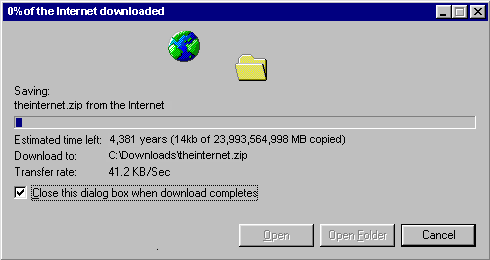So much has been said about this subject in the past but I feel I must reiterate the importance of getting your own domain name if you are to be taken seriously in the home business world.
There is nothing more offputting than seeing an ad with a free domain name attached (ie http://www.freedomain.yourname.com). I personally will bypass such businesses.
The fact of the matter is that a business person who is not prepared to pay a sum, of at most $35 per year, to register a domain name just doesn't deserve to be taken seriously. You can of course find sites that will register your domain name for as little as $10 per year. You can then get your website hosted for a few dollars per month.
Registering your domain name builds credibility and creates an identity for your business.
When choosing a domain name it is better to use a term that is going to stick in the mind of prospective buyers, something that your visitors will remember you by. For example "Internet.com" would be an example of a relatively short and catchy domain. Unfortunately a greater % of two word domain names have been taken up by the 100,000s of online businesses but if you persist you can get something suitable.
It is also a great idea to use keywords relating to the type of business you run. You can see from my own two businesses above that this has been my strategy. This can significantly enhance
search engine ranking for these keywords and I now rank in the top pages of Google/Yahoo for both these sites with the terms "work from home" and work at home business information.
Another important aspect of owning your own domain is when it comes to e-mail marketing. Who are you more likely to buy from, onepreneur@yahoo.com or one@onepreneur.com? Selling online is all about building trust between you and your customers and registering your domain can go a long way towards building this bond between you and your website visitors.
Whether you use the above strategies or not, it is extremely important that you take that first step now and register your own domain name. At the very least the name will become your property and, depending on the amount of work you put into building your web presence, may become very valuable one day.
Good luck and I wish you every success with your business.
There is nothing more offputting than seeing an ad with a free domain name attached (ie http://www.freedomain.yourname.com). I personally will bypass such businesses.
The fact of the matter is that a business person who is not prepared to pay a sum, of at most $35 per year, to register a domain name just doesn't deserve to be taken seriously. You can of course find sites that will register your domain name for as little as $10 per year. You can then get your website hosted for a few dollars per month.
Registering your domain name builds credibility and creates an identity for your business.
When choosing a domain name it is better to use a term that is going to stick in the mind of prospective buyers, something that your visitors will remember you by. For example "Internet.com" would be an example of a relatively short and catchy domain. Unfortunately a greater % of two word domain names have been taken up by the 100,000s of online businesses but if you persist you can get something suitable.
It is also a great idea to use keywords relating to the type of business you run. You can see from my own two businesses above that this has been my strategy. This can significantly enhance
search engine ranking for these keywords and I now rank in the top pages of Google/Yahoo for both these sites with the terms "work from home" and work at home business information.
Another important aspect of owning your own domain is when it comes to e-mail marketing. Who are you more likely to buy from, onepreneur@yahoo.com or one@onepreneur.com? Selling online is all about building trust between you and your customers and registering your domain can go a long way towards building this bond between you and your website visitors.
Whether you use the above strategies or not, it is extremely important that you take that first step now and register your own domain name. At the very least the name will become your property and, depending on the amount of work you put into building your web presence, may become very valuable one day.
Good luck and I wish you every success with your business.


